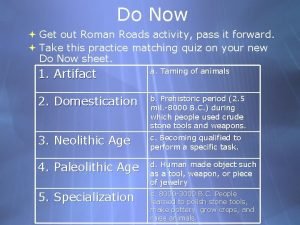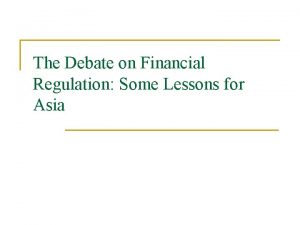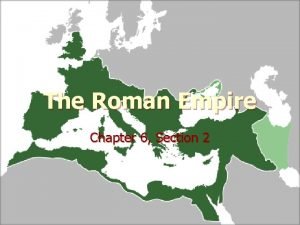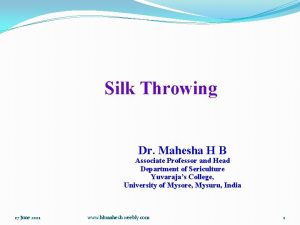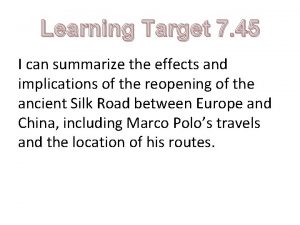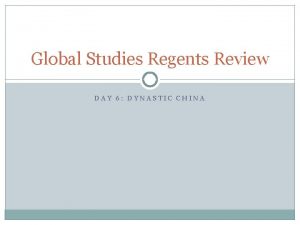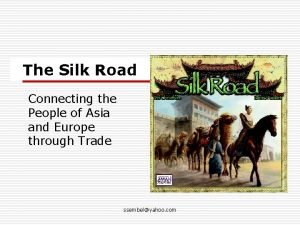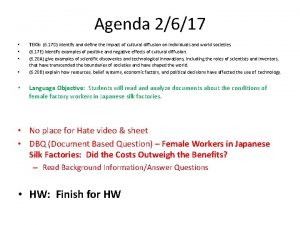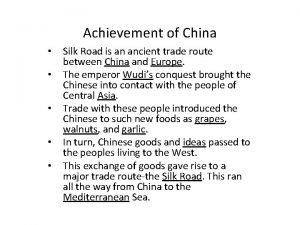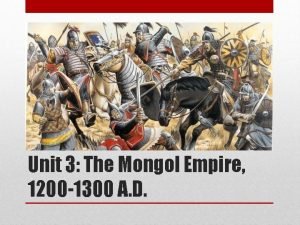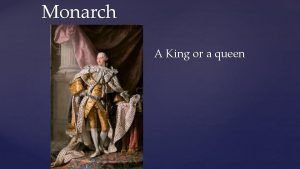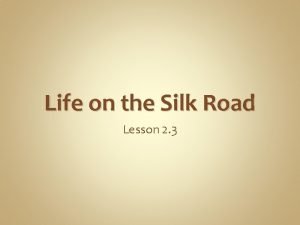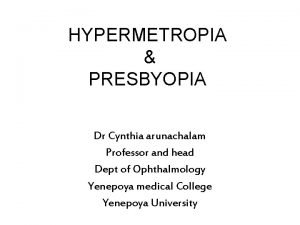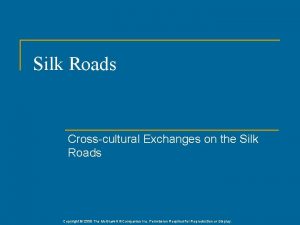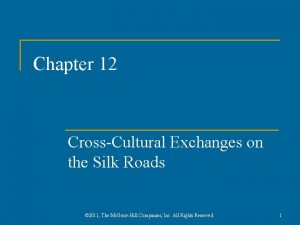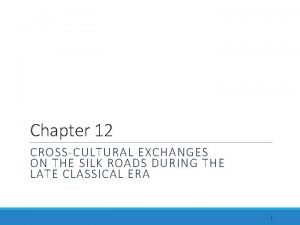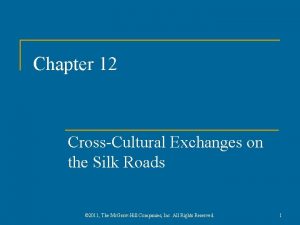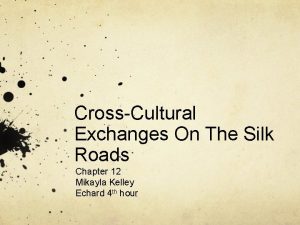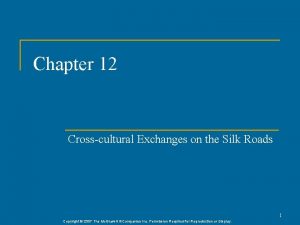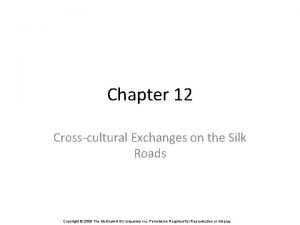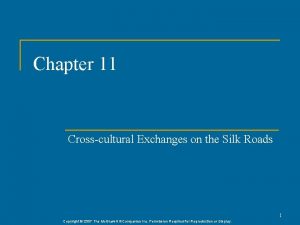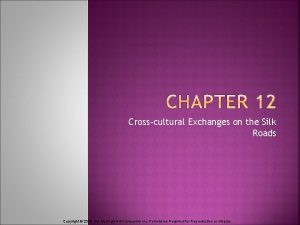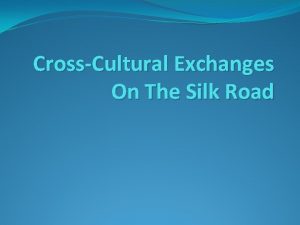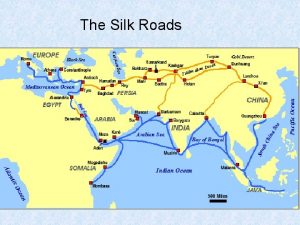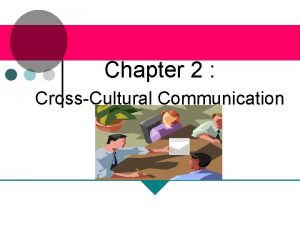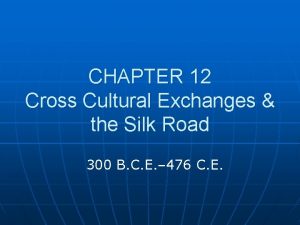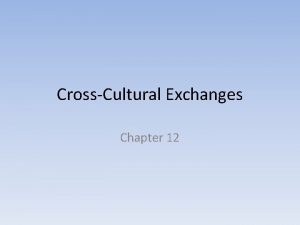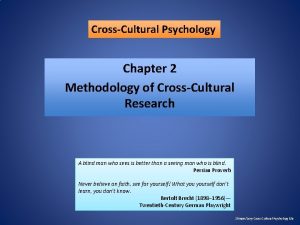Chapter 12 CrossCultural Exchanges on the Silk Roads






























- Slides: 30

Chapter 12 Cross-Cultural Exchanges on the Silk Roads During the Late Classical Era Copyright © 2015 Mc. Graw-Hill Education. All rights reserved. No reproduction or distribution without the prior written consent of Mc. Graw-Hill Education. 1

Long-Distance Trade and the Silk Roads Network n n Lack of police enforcement outside of established settlements Changed in classical era q q Improvement of infrastructure Development of empires Copyright © 2015 Mc. Graw-Hill Education. All rights reserved. No reproduction or distribution without the prior written consent of Mc. Graw-Hill Education. 2

Hellenistic Trade Networks n n Dramatic increase in trade due to Greek colonization Maintenance of roads, bridges Discovery of monsoon wind patterns Increased tariff revenues used to maintain open routes Copyright © 2015 Mc. Graw-Hill Education. All rights reserved. No reproduction or distribution without the prior written consent of Mc. Graw-Hill Education. 3

Trade in the Hellenistic World n Bactria and India q n Persia and Egypt q n Grain Mediterranean region q n Spices, pepper, cosmetics, gems, pearls Wine, olive oil, jewelry, art Development of professional merchant class Copyright © 2015 Mc. Graw-Hill Education. All rights reserved. No reproduction or distribution without the prior written consent of Mc. Graw-Hill Education. 4

The Silk Roads n n Named for principal commodity from China Dependent on imperial stability Overland trade routes from China to Roman empire Sea lanes and maritime trade as well Copyright © 2015 Mc. Graw-Hill Education. All rights reserved. No reproduction or distribution without the prior written consent of Mc. Graw-Hill Education. 5

The Silk Roads, 200 B. C. E. – 300 C. E. Copyright © 2015 Mc. Graw-Hill Education. All rights reserved. No reproduction or distribution without the prior written consent of Mc. Graw-Hill Education. 6

Organization of Long-Distance Trade n Divided into small segments q n Trade done in stages Sea trade q q Malay and Indian mariners Persian, Egyptian, Greek Copyright © 2015 Mc. Graw-Hill Education. All rights reserved. No reproduction or distribution without the prior written consent of Mc. Graw-Hill Education. 7

Spread of Buddhism and Hinduism n n Merchants carried religious ideas along Silk Roads India through central Asia to east Asia Cosmopolitan centers promoted development of monasteries to shelter traveling merchants Buddhism became dominant faith of Silk Roads, about 100 B. C. E. – 800 C. E. Copyright © 2015 Mc. Graw-Hill Education. All rights reserved. No reproduction or distribution without the prior written consent of Mc. Graw-Hill Education. 8

The Spread of Buddhism, Hinduism, and Christianity, 200 B. C. E. – 400 C. E. Copyright © 2015 Mc. Graw-Hill Education. All rights reserved. No reproduction or distribution without the prior written consent of Mc. Graw-Hill Education. 9

Buddhism in China n n Originally, Buddhism restricted to foreign merchant populations Gradually spread to larger population, beginning about fifth century C. E. Copyright © 2015 Mc. Graw-Hill Education. All rights reserved. No reproduction or distribution without the prior written consent of Mc. Graw-Hill Education. 10

Buddhism and Hinduism in Southeast Asia n n Sea lanes in Indian Ocean First century C. E. , clear Indian influence in southeast Asia q q q Rulers called “rajas” Sanskrit used for written communication Buddhism, Hinduism increasingly popular faiths Copyright © 2015 Mc. Graw-Hill Education. All rights reserved. No reproduction or distribution without the prior written consent of Mc. Graw-Hill Education. 11

Christianity in the Mediterranean Basin n Gregory the Wonderworker, central Anatolia, third century C. E. Christianity spread through Middle East, north Africa, Europe Sizeable communities as far east as India Copyright © 2015 Mc. Graw-Hill Education. All rights reserved. No reproduction or distribution without the prior written consent of Mc. Graw-Hill Education. 12

Christianity in Southwest Asia n n Along with Jews and Zoroastrians Influence of ascetic practices from India Desert-dwelling hermits, monastic societies After fifth century C. E. , followed Nestorius q Emphasized human nature of Jesus Copyright © 2015 Mc. Graw-Hill Education. All rights reserved. No reproduction or distribution without the prior written consent of Mc. Graw-Hill Education. 13

The Spread of Manichaeism n n Mani (216– 272 C. E. ), devout Zoroastrian Viewed himself prophet for all humanity Influenced by Christianity and Buddhism Dualist q q q Good vs. evil Light vs. dark Spirit vs. matter Copyright © 2015 Mc. Graw-Hill Education. All rights reserved. No reproduction or distribution without the prior written consent of Mc. Graw-Hill Education. 14

Manichaean Ethics n Devout: “the elect” q q q n Ascetic lifestyle Celibacy, vegetarianism Life of prayer and fasting Laity: “hearers” q Material supporters of “the elect” Copyright © 2015 Mc. Graw-Hill Education. All rights reserved. No reproduction or distribution without the prior written consent of Mc. Graw-Hill Education. 15

Decline of Manichaeism n n Spread through silk routes to major cities in Roman empire Zoroastrian opposition provoked Sasanid persecution q n Mani arrested, died in captivity Romans, fearing Persian influence, also persecuted Copyright © 2015 Mc. Graw-Hill Education. All rights reserved. No reproduction or distribution without the prior written consent of Mc. Graw-Hill Education. 16

The Spread of Epidemic Disease n n Role of trade routes in spread of pathogens Limited data, but trends in demographics reasonably clear Smallpox, measles, bubonic plague Effects: economic slowdown, move to regional self-sufficiency Copyright © 2015 Mc. Graw-Hill Education. All rights reserved. No reproduction or distribution without the prior written consent of Mc. Graw-Hill Education. 17

Epidemics in the Han and Roman Empires Copyright © 2015 Mc. Graw-Hill Education. All rights reserved. No reproduction or distribution without the prior written consent of Mc. Graw-Hill Education. 18

Internal Decay of the Han State n n Court intrigue Problem of land distribution q n n Large landholders develop private armies Epidemics Peasant rebellions q Yellow Turban uprising, 184 C. E. Copyright © 2015 Mc. Graw-Hill Education. All rights reserved. No reproduction or distribution without the prior written consent of Mc. Graw-Hill Education. 19

Collapse of the Han Dynasty n n n Generals assumed authority, reduced emperor to puppet figure Alliance with landowners Han dynasty abolished, 200 C. E. q n Replaced by three kingdoms Increase in immigration of northern nomads Copyright © 2015 Mc. Graw-Hill Education. All rights reserved. No reproduction or distribution without the prior written consent of Mc. Graw-Hill Education. 20

China after the Han Dynasty, 220 C. E. Copyright © 2015 Mc. Graw-Hill Education. All rights reserved. No reproduction or distribution without the prior written consent of Mc. Graw-Hill Education. 21

Sinicization of Nomadic Peoples n n Social and cultural changes to Chinese way of life taking place Nomadic peoples increasingly adapted to Chinese environment q q n Agriculture Adoption of Chinese names, dress, intermarriage Confucian tradition’s loss of credibility q Turn toward Daoism and Buddhism Copyright © 2015 Mc. Graw-Hill Education. All rights reserved. No reproduction or distribution without the prior written consent of Mc. Graw-Hill Education. 22

Internal Decay in the Roman Empire n n The “barracks emperors” For half century, 235– 284 C. E. , twenty-six claimants to the throne q n n All but one killed in power struggles Epidemics Disintegration of imperial economy in favor of local and regional self-sufficient economies Copyright © 2015 Mc. Graw-Hill Education. All rights reserved. No reproduction or distribution without the prior written consent of Mc. Graw-Hill Education. 23

Diocletian (r. 284– 305 C. E. ) n n Divided empire into two administrative districts Co-emperors, dual lieutenants q n n n Tetrarchs Currency, budget reform Relative stability disappeared after Diocletian’s death, followed by civil war Constantine emerged victorious by 324 C. E. q Construction of Constantinople Copyright © 2015 Mc. Graw-Hill Education. All rights reserved. No reproduction or distribution without the prior written consent of Mc. Graw-Hill Education. 24

Germanic Invasions n Visigoths, influenced by Roman law, Christianity q n n n Formerly buffer states for Roman empire Attacked by Huns under Attila in fifth century C. E. Massive migration of Germanic peoples into Roman empire Sacked Rome in 410 C. E. , established Germanic emperor in 476 C. E. Copyright © 2015 Mc. Graw-Hill Education. All rights reserved. No reproduction or distribution without the prior written consent of Mc. Graw-Hill Education. 25

Germanic Invasions and the Collapse of the Western Roman Empire, 450– 476 C. E. Copyright © 2015 Mc. Graw-Hill Education. All rights reserved. No reproduction or distribution without the prior written consent of Mc. Graw-Hill Education. 26

Cultural Change in the Late Roman Empire n Growth of Christianity q q q n Constantine’s vision, 312 C. E. Edict of Milan, 313 C. E. , allowing Christian practice Constantine’s conversion to Christianity proclaimed official religion of Roman empire by Emperor Theodosius, 380 C. E. Copyright © 2015 Mc. Graw-Hill Education. All rights reserved. No reproduction or distribution without the prior written consent of Mc. Graw-Hill Education. 27

St. Augustine (354– 430 C. E. ) n n Bishop of north African city of Hippo Experimented with Greek thought, Manichaeism Conversion to Christianity, 387 C. E. Major theologian Copyright © 2015 Mc. Graw-Hill Education. All rights reserved. No reproduction or distribution without the prior written consent of Mc. Graw-Hill Education. 28

The New Testament and Orthodox Christianity n n Efforts to standardize Christian teachings Search for clearly defined doctrine Intense debates about quality, authority of early Christian writings By late fourth century, near consensus on canonical scriptures: New Testament q Rejection of other writings would influence development of orthodox or correct teaching Copyright © 2015 Mc. Graw-Hill Education. All rights reserved. No reproduction or distribution without the prior written consent of Mc. Graw-Hill Education. 29

The Institutional Church n Church hierarchy established q q q Bishop of Rome and patriarchs of Jerusalem, Antioch, Alexandria, Constantinople Subordinate bishops presided over dioceses Church councils assembled n n Nicaea (325 C. E. ); Chalcedon (451 C. E. ) Took up issues such as Jesus’ nature Copyright © 2015 Mc. Graw-Hill Education. All rights reserved. No reproduction or distribution without the prior written consent of Mc. Graw-Hill Education. 30
 Modern roads vs roman roads venn diagram
Modern roads vs roman roads venn diagram Cuatrocientos o cuatroscientos
Cuatrocientos o cuatroscientos Exchanges over trillion trading volume this
Exchanges over trillion trading volume this Ams ix remote peering
Ams ix remote peering Chapter 6 section 2 the roman empire answer key
Chapter 6 section 2 the roman empire answer key Woollen textile industry in india
Woollen textile industry in india Trans-saharan trade route
Trans-saharan trade route Throwing process of silk
Throwing process of silk Silk is a natural protein fiber some forms of which can be
Silk is a natural protein fiber some forms of which can be Silkworm
Silkworm Silk road goods traded
Silk road goods traded Say silk 5 times
Say silk 5 times Which phrase correctly describes the tang dynasty
Which phrase correctly describes the tang dynasty How silk is produced
How silk is produced Silk road mind map
Silk road mind map Silk is a natural protein fiber some forms of which can be
Silk is a natural protein fiber some forms of which can be Costco pharmacy marysville
Costco pharmacy marysville Female workers in japanese silk factories dbq answers
Female workers in japanese silk factories dbq answers Silk road achievements
Silk road achievements Cambulac
Cambulac Spider goat silk
Spider goat silk Wine rice indigo silk tobacco
Wine rice indigo silk tobacco Silk road map activity
Silk road map activity Julie silk
Julie silk Shot silk appearance of retina
Shot silk appearance of retina Spider goat silk
Spider goat silk Fagara silk
Fagara silk Fatpp
Fatpp Pantaloon hernia
Pantaloon hernia Processus vaginalis
Processus vaginalis Cadbury dairy milk
Cadbury dairy milk
